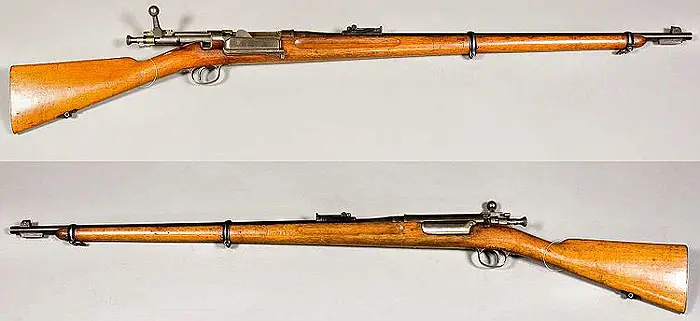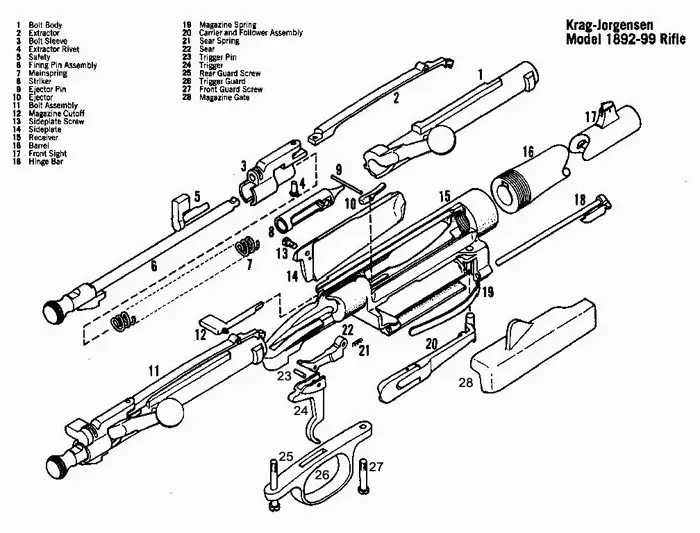|
The U.S. Krag-Jorgensen Rifle and Carbine By David Tong The late 19th Century was a watershed development time for the infantry rifle. The advent of smokeless powder, the jacketed bullet and the turn bolt repeating rifle created a mad rush to adopt all three technologies to take advantage of the improvements in accuracy, long range trajectory and the reduction of tell-tale smoke. (The "haze of battle" was very real in the black powder era.) One of these nations was Norway. Captain Ole Krag of the Norwegian Army headed the government arsenal and Erik Jorgensen, a gunsmith, together developed a cartridge magazine unlike any other. Originally, it was designed to hold ten rounds of ammunition in a semi-circle around the receiver of a rifle, in order to not have a feed device protruding from the bottom of the action. Although it was thought this magazine could be used on any action, it was considered too bulky. A prototype rifle was sent to Denmark and they concluded something less bulky was needed, so a five round magazine was created. This magazine was then incorporated into a new rifle action. Like some other early bolt actions, the rear receiver bridge was split to allow passage of the rifle�s bolt handle when the bolt was removed. This new Krag-Jorgensen action's magazine protruded from the right side of the rifle. It had a spring loaded box with a machined tab on its top and a hinge on its bottom. The shooter's right thumb is used to open the door. Rounds can then be put into the open internal magazine without regard how the rims are placed, as long as the bulleted end is pointed forward (toward the muzzle of the rifle). In addition, the action incorporated a magazine cut off that allowed it to be used as a single shot. Taken together, these two innovations reflected military thinking that the conservation of ammunition during battle was highly preferable and encouraged the slowing of fire by troops for greater accuracy. The Danes adopted the new Krag-Jorgensen rifle in 1889. Its major difference was that they modified the magazine door box by hinging it at its front, instead of at its bottom, so loading it meant pivoting the door forward, rather than downward.  The U.S. Army held trials in New York in 1892 to select a new infantry rifle to replace the single shot 1873 "Trapdoor" Springfield. There were some 53 rifles submitted, although the finalists were all European rifles, including the Lee, Mauser and Krag-Jorgensen. After prevailing in the trials, the Krag was selected in mid-1893. Army Ordnance Board personnel liked the idea of mechanically slowing the rate of fire and consumption of ammunition, considering it an advantage. The prevailing thought was that soldiers should be trained to fire their new repeating rifles as they did their single shots, manually loading the chamber by hand for each shot, rather than by cycling the bolt. The magazine should be held in reserve for contingencies.There were about a half-million Krag-Jorgensen rifles and carbines built under license by the U.S. Government's Springfield Armory, in four major sub-types, between 1894 and 1904. These are the M1892, M1896, M1898 (most prevalent) and the M1899. These were built both in rifle and cavalry carbine models; the latter being substantially shorter and lighter, at the price of increased recoil. Rifles had 30� barrels and weighed about 9.25 pounds, while carbines carried a 22� tube and were about 1.5 pounds lighter. Norway, Denmark and the U.S. were the only nations to adopt the Krag, although it was a very well finished and smooth operating rifle. The American Krag bolt locks with a single lug, although the root of the bolt handle functions as a safety lug. In addition to its side loading magazine, another of the several peculiarities of the action was a long, top mounted extractor. Hinged with a rivet at the rear of the bolt body, it must be swiveled to the right and lifted up, off of the bolt, as the bolt is withdrawn to remove the bolt from the receiver.  Mauser introduced their �Spanish� Model of 1893 and that rifle made use of a stripper clip for the first time. This proved to be unfortunate for the United States when it found itself embroiled in the Spanish-American War in 1898. Clip fed Mausers easily provided higher rates of fire than the Krag rifles used by American troops, giving the Spanish a tactical advantage and markedly increasing the number of American casualties. The rapid adoption of clip or charger loaded magazines to the infantry rifles of all other major powers meant that the Krag-Jorgensen quickly became obsolescent. As a result, the Krag was short lived in American service. It was officially replaced after only ten years by the 1903 Springfield rifle and completely phased out of use by the regular Army by 1907. Krag rifles were used by American troops during the Spanish-American War (1898), Philippine Insurrection (1899-1902) and Boxer Rebellion in China (1899-1901). In addition, several Engineer companies carried Krags into the Great War (WW I) in 1917. The cartridge used by the American Krag-Jorgensen rifle was known officially as the �.30 U.S. Government� and much more widely by its civilian designation, the .30-40 Krag. (A .30 caliber bullet powered by 40 grains of the then new smokeless powder.) It is a rimmed, bottleneck design with considerable body taper for easy and reliable extraction, rather similar in appearance to its historical contemporary the .303 British. (The modern ballistics of the two cartridges as factory loaded in the U.S. are nearly identical.) Due to the early metallurgy and single heat treatment (case hardening) of the action, the .30-40 cartridge operated at the relatively low maximum average pressure (MAP) of about 40,000 psi. It drove a 220 grain round nosed bullet at a leisurely muzzle velocity (MV) of 1,970 fps. with a muzzle energy (ME) of 1724 ft. lbs. from the Krag carbine and only slightly faster (2000 fps) from the long barreled rifle. A later attempt to increase velocity and provide a flatter trajectory raised the MV to about 2,200 fps and the MAP to some 45,000 psi. However, the higher pressure caused bolt lugs to fracture, so the 45,000 psi round was quickly withdrawn from service only six months after its issuance, in October 1899. Today, the .30-40 is loaded with a 180 grain spitzer bullet at a MV of 2430 fps and ME of 2360 ft. lbs. (Winchester and Remington figures), although the MAP remains 40,000 CUP. This increased performance is made possible by modern smokeless powders. In addition to the Krag-Jorgensen Army rifle, a couple of notable contemporary civilian hunting rifles were chambered for the .30-40 cartridge. These included Winchester's Model 1885 falling block single shot and Model 1895 lever action repeater. Much more recently, in the 1970's, Ruger produced some No. 3 falling block carbines in the caliber. The .30-40 cartridge did not have a great reputation as a man-stopper during the Philippine campaign. It was said that drug-addled Moro fighters were able to absorb multiple hits before succumbing. Anecdotal history can be misleading at times, as during the same Philippine campaign the .45 Colt revolver earned a good reputation as a man stopper. In reality, the .45 Colt launches a 255 grain RN bullet at only 860 fps with a paltry 419 ft. lbs. of muzzle energy and the performance gap between the rifle bullet and the handgun bullet widens dramatically as the range increases. Go figure. A U.S. Krag belonging to my Scoutmaster was the first centerfire rifle I ever fired. Someone had �sporterized� it by cutting off about six inches of barrel and the same amount of stock wood up front. I do remember it kicking hard, at least to someone with no rifle experience. These days, however, I consider the .30-40 to be pretty tame. Due mostly to its relatively low pressure limit that makes the Krag-Jorgensen action unsuitable for modern cartridges and its unique magazine system, military Krags are no longer candidates for conversion into hunting rifles. While a smooth action to use, the cost of restocking one would be prohibitive due the complexity of the inletting necessary for that side magazine. In addition, the split receiver bridge complicates mounting a riflescope. It is best to keep a surviving Krag in original condition. Admire it for its workmanship and history, rather than for any modern functionality. That said, they are fun to shoot! |